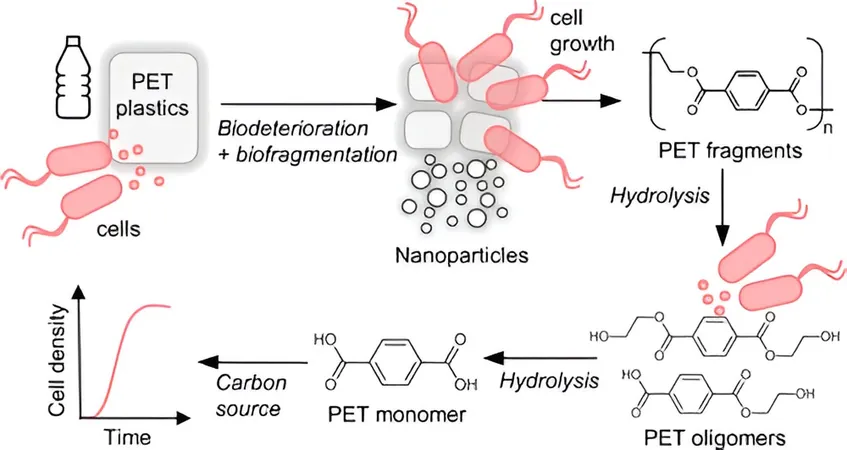
Groundbreaking Discovery: Plastic-Eating Enzyme Found in Sewage Microbes!
2024-10-05
Author: Jia
Introduction
Plastic pollution has reached alarming levels, and a significant portion of this crisis is attributed to polyethylene terephthalate, commonly known as PET. This versatile polymer is used widely in everyday items such as plastic bottles, containers, and even clothing. However, scientists have made a remarkable discovery that could revolutionize how we tackle plastic waste: an enzyme capable of breaking down PET, found in the most unexpected of environments—microbes dwelling in sewage sludge.
The Plastic Pollution Crisis
Published in the prestigious journal Environmental Science & Technology, the study highlights that microplastics are infiltrating ecosystems worldwide, from the depths of remote oceans to our very own bodies. It’s no wonder they also contaminate wastewater. Unfortunately, their minuscule size often allows them to evade conventional water treatment processes, ultimately re-entering nature through effluents.
Microbes as a Solution
But here’s the twist—effluents are not just a problem; they are also a breeding ground for microorganisms that thrive on plastic. One of these bacteria, Comamonas testosteroni, intriguingly named for its ability to degrade various sterols, including testosterone, shows promising potential in tackling PET.
Research Initiatives
While other bacterial strains, including the notorious E. coli, have been genetically engineered to convert plastics into useful substances, C. testosteroni naturally consumes polymers such as the ones found in laundry detergents, along with terephthalate, a building block of PET. This piqued the interest of researcher Ludmilla Aristilde and her team, who sought to investigate whether C. testosteroni could produce enzymes capable of degrading PET.
To test this hypothesis, the team incubated a strain of C. testosteroni with PET films and pellets. Observations revealed a striking preference for the rougher surfaces of the pellets, which the bacteria broke down more effectively than the smoother films. In a bid to accurately mimic wastewater conditions, the researchers introduced acetate, an ion prevalent in such environments. This addition led to a remarkable increase in bacterial colonies, enhancing the bacteria’s ability to break down plastics.
Breakthrough Results
Astoundingly, while C. testosteroni produced nano-sized PET particles, it also fully degraded the polymer into its monomers—nutrients that the bacteria and other microorganisms can utilize for growth and energy. This finding has the potential to shift the paradigm in wastewater treatment, opening doors to upcycling plastic waste into beneficial components.
Identifying the Enzyme
The next step for the research team was to pinpoint the key enzyme responsible for the plastic-degrading abilities of C. testosteroni. Their analysis revealed that this novel enzyme, while unique in its overall protein sequence, featured a similar binding pocket known to be involved in the breakdown process of PET.
Potential for Biotechnological Applications
To further validate their findings, the researchers inserted the gene encoding this enzyme into a microbe that naturally lacks the capability to degrade PET, and astonishingly, the engineered organism gained the ability to break down the polymer. This breakthrough not only sheds light on natural plastic degradation mechanisms but also suggests a promising avenue for biotechnological applications in waste management.
Conclusion
As the world contends with the grave consequences of plastic pollution, this discovery may well mark the beginning of an innovative approach to not only combat plastic waste but also to possibly turn harmful materials into valuable resources. Could this be the solution we’ve all been waiting for? Stay tuned for more updates on this exciting development!



 Brasil (PT)
Brasil (PT)
 Canada (EN)
Canada (EN)
 Chile (ES)
Chile (ES)
 España (ES)
España (ES)
 France (FR)
France (FR)
 Hong Kong (EN)
Hong Kong (EN)
 Italia (IT)
Italia (IT)
 日本 (JA)
日本 (JA)
 Magyarország (HU)
Magyarország (HU)
 Norge (NO)
Norge (NO)
 Polska (PL)
Polska (PL)
 Schweiz (DE)
Schweiz (DE)
 Singapore (EN)
Singapore (EN)
 Sverige (SV)
Sverige (SV)
 Suomi (FI)
Suomi (FI)
 Türkiye (TR)
Türkiye (TR)